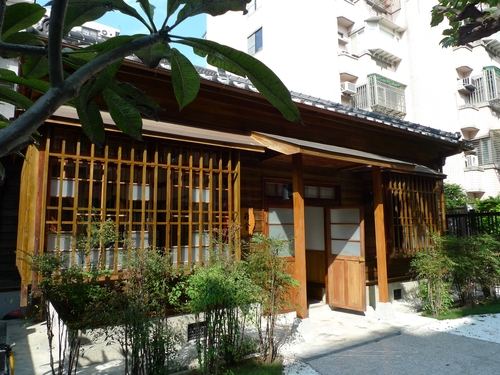
The Liang Shih-Chiu House was built in 1933, when Taiwan was still under Japanese colonial rule. Its address during the colonial period was 204 Koteicho district (古亭町204番地); its first resident was Tomita Yoshisuke (富田義介), an English instructor at Taihoku Higher School. After 1945, when Taiwan was handed over to the Republic of China, Taihoku Higher School became Taiwan Provincial Teachers College, and the house became a faculty residence for the newly established school. The residence was occupied successively by Chang Ju-Lin (張儒林), Liang Shih-Chiu (梁實秋), and Ning Chu(甯杼). Liang Shih-Chiu moved into the residence in 1952 and stayed until January 1959. One of the many places that he resided in during his life, it was also the first home that he lived in after relocating to Taiwan from China. In recognition of the great historical value and meaning of the house, the Taipei City government designated it a historical heritage site in 2003. The city government gave the following reasons for its decision:
First, Professor Liang Shih-Chiu was a well-known professor, the teacher of numerous students, many of whom went on to have distinguished careers of their own. He was also the chief editor of a widely-used English-Chinese dictionary, and the compiler of English textbooks used in the nation’s middle schools. He introduced the KK phonetic system into Taiwan, which has had a profound impact on English education in Taiwan. His prose essays have been enormously popular. His translations of Shakespeare’s works have enhanced the nation’s understanding of western literature.
Second, the residence is a Japanese-style wooden house located in the middle of a bustling city filled with concrete buildings; it is a precious historical artifact, worthy of preservation.
At the time, however, the residence, a single-story household, was in disrepair. The roof tiles had fallen off; the walls were crumbling and in danger of falling in on themselves. National Taiwan Normal University, which was entrusted with restoring the dilapidated structure, conducted damage and repair surveys throughout 2005. Between October 2010 and June 2011, the residence was restored to its original condition.

In terms of its size, the Liang Shih-Chiu House is roughly 100 square meters. In the middle of the structure is a long central corridor, a feature typical of the architectural style of the time. The house was a middle-class residence, but it was built in imitation of an upper-class residence. In terms of style, it is a fusion of eastern and western elements. The foyer and the reception area are western, but the living room, bedroom, dining room, kitchen, closet, and bathroom are all Japanese style.
The enormous breadfruit tree located at the front of the house was one that Liang Shih-Chiu would never forget. In January 1973, after he had moved to the United States, he wrote a poem on the occasion of his seventieth birthday. Through his description of the tree, Liang expressed how deeply he still missed his first wife Cheng Chi-Shu (程季淑): “All is well, yet I am sullen without cause. Time and again the wind howls. Best not to mention that the year is coming to an end. / Do not complain that your old house cannot be found; the breadfruit tree still stands in the corner, for sure. / Looking far into the empty sky, I feel lost; filled with tears, I sit down in this building, beyond which are countless green trees. / The past is gone like mist, like fallen catkins. But thinking of you I feel young once more.”